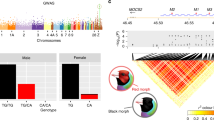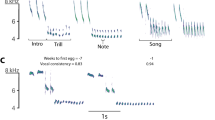Abstract
Several reports have shown that greater heterozygosity (both between individuals and between populations) is associated with lower morphological variance and asymmetry. Most previous work concerned poikilothermic organisms (for example, fish1–3, butterflies4, lizards5, shellfish6–9, salamanders10 and plants11–13). Reports concerning two homoiotherms gave conflicting results14–16. The report by Handford16 on a songbird, Zonotrichia capensis, failed to support the relationship, although these results have been questioned in the literature17,18. Handford suggested that the lack of relationship in Zonotrichia could indicate a fundamental difference between homoiotherms and poikilotherms, reflected in their apparent differences in heterozygosity19. However, we report here on electrophoretic and morphometric studies20–25 on another songbird species (Passer domesticus), in which the relationship appears to be upheld. We find consistently, among four locality samples, that the class of individuals of greatest allozyme heterozygosity nearly always exhibits the lowest multivariate morphological variance, and the class of greatest homozygosity nearly always exhibits the highest
This is a preview of subscription content, access via your institution
Access options
Subscribe to this journal
Receive 51 print issues and online access
$199.00 per year
only $3.90 per issue
Buy this article
- Purchase on Springer Link
- Instant access to full article PDF
Prices may be subject to local taxes which are calculated during checkout
Similar content being viewed by others
References
Mitton, J. B. Nature 273, 661–662 (1978).
Vrijenhoek, R. C. & Lerman, S. Evolution 36, 768–776 (1982).
Leary, R. F., Allendorf, R. W. & Knudsen, K. L. Nature 301, 71–72 (1983).
Eanes, W. F. Nature 276, 263–264 (1978).
Soule, M. Evolution 33, 396–401 (1979).
Singh, S. M. & Zouros, E. Evolution 32, 342–345 (1978).
Zouros, E., Singh, S. M. & Miles, H. E. Evolution 34, 856–867 (1980).
Koehn, R. K. & Shumway, S. E. Mar. Biol. Lett. 3, 35–42 (1982).
Kat, P. W. Am. Nat. 119, 824–832 (1982).
Pierce, B. A. & Mitton, J. B. Heredity 73, 250–253 (1982).
Knowles, P. & Mitton, J. B. Silvae Genetica 29, 114–118 (1980).
Mitton, J. B., Knowles, P., Sturgeon, K. B., Linhart, Y. B. & Davis, M. in Isozymes of North American Forest Trees and Forest Insects (USDA, General Technical Report PSW-48, 1979).
El-Kassaby, K. Genetics 101, 103–115 (1982).
Cothran, E. G., Chesser, R. K., Smith, M. H. & Johns, P. E. Evolution 37, 282–291 (1983).
Smith, M. H., Chesser, R. K., Cothran, E. G. & Johns, P. E. Antler Development in Cervidae (ed. Brown, R. D.) (Caesar Kleberg Wildlife Research Institute, Texas A & I University, 1982).
Handford, P. Nature 286, 261–262 (1980).
Eanes, W. F. Nature 290, 609–610 (1981).
Handford, P. Nature 290, 610 (1981).
Nevo, E. Theor. population Biol. 13, 121–177 (1978).
Klitz, W. thesis, Kansas Univ. (1972).
Johnston, R. F. & Fleischer, R. C. Auk 98, 503–511 (1981).
Fleischer, R. C. & Johnston, R. F. Nature 298, 747–749 (1982).
Fleischer, R. C. thesis, Kansas Univ. (1983).
Fleischer, R. C. Evolution (in the press).
Johnston, R. F. & Klitz, W. J. in Granivorous Birds in Ecosystems Vol. 12 (eds Pinowski, J. & Kendeigh, S. C. ) ch. 2 (Cambridge University Press, 1977).
Johnston, R. F. & Selander, R. K. Evolution 21, 1–28 (1971).
Van Valen, L. J. theor Biol. 45, 235–247 (1974).
Van Valen, L. Evolutionary Theory 4, 33–43 (1978).
Johnston, R. F. Syst Zool. 22, 219–226 (1973).
Mitton, J. B. & Pierce, B. A. Genetics 95, 1043–1054 (1980).
Chakraborty, R. Genetics 98, 461–466 (1981).
Bulatova, N. S., Radjabli, S. I. & Panov, E. N. Experientia 28, 1369–1371 (1972).
Cole, S. R. & Parkin, D. T. Biol. J. Linn. Soc. 15, 13–22 (1981).
Lerner, I. M. Genetic Homeostasis (Oliver & Boyd, Edinburgh, 1954).
Chakraborty, R. & Ryman, N. Genetics 103, 149–152 (1983).
Author information
Authors and Affiliations
Rights and permissions
About this article
Cite this article
Fleischer, R., Johnston, R. & Klitz, W. Allozymic heterozygosity and morphological variation in house sparrows. Nature 304, 628–630 (1983). https://doi.org/10.1038/304628a0
Received:
Accepted:
Issue Date:
DOI: https://doi.org/10.1038/304628a0
This article is cited by
-
Evolution of Adaptation and Mate Choice: Parental Relatedness Affects Expression of Phenotypic Variance in a Natural Population
Evolutionary Biology (2008)
-
Inheritance of Behavioral and Neuroanatomical Phenotypical Variance: Hybrid Mice Are Not Always More Stable Than Inbreds
Behavior Genetics (2006)
-
Developmental stability and canalization of limb bones of brown haresLepus europaeus with varying levels of heterozygosity
Acta Theriologica (2005)
-
Lack of correlation between heterozygosity and fitness in forked fungus beetles
Heredity (1993)
-
The genetic basis of developmental stability. I. Relationships between stability, heterozygosity and genomic coadaptation
Genetica (1993)
Comments
By submitting a comment you agree to abide by our Terms and Community Guidelines. If you find something abusive or that does not comply with our terms or guidelines please flag it as inappropriate.



